Knowing how to test your blood pressure accurately is crucial for maintaining good health. High blood pressure (hypertension) is a silent killer, often showing no symptoms until it's caused significant damage. Regularly monitoring your blood pressure at home can help you detect potential problems early and work with your doctor to manage your health effectively. This guide provides a step-by-step explanation of how to properly test your blood pressure using a home blood pressure monitor.
Understanding Blood Pressure Readings
Before we delve into the process, let's briefly understand what a blood pressure reading signifies. Blood pressure is measured in millimeters of mercury (mmHg) and expressed as two numbers:
- Systolic Pressure: The top number represents the pressure in your arteries when your heart beats.
- Diastolic Pressure: The bottom number represents the pressure in your arteries when your heart rests between beats.
For example, a reading of 120/80 mmHg indicates a systolic pressure of 120 mmHg and a diastolic pressure of 80 mmHg. Your doctor will use these numbers to assess your blood pressure and determine if any action is needed.
Equipment You'll Need
To accurately measure your blood pressure at home, you'll need:
- An Automatic Blood Pressure Monitor: These monitors are easy to use and provide accurate readings. Choose a monitor that is validated and approved by reputable organizations.
- A Comfortable Chair: Sit in a relaxed position during the measurement to ensure accuracy.
- A Watch or Timer: While not strictly necessary for automatic monitors, it's useful to time your rest periods.
Step-by-Step Guide to Testing Your Blood Pressure
Follow these steps for an accurate blood pressure reading:
1. Preparation is Key:
- Rest for at least 5 minutes: Avoid strenuous activity or caffeine consumption before testing.
- Empty your bladder: A full bladder can affect your reading.
- Find a quiet place: Minimize distractions to stay relaxed.
- Sit comfortably: Sit with your back supported, feet flat on the floor, and your arms resting on a table.
2. Positioning the Cuff:
- Locate your brachial artery: This artery is located on the inner side of your upper arm, just above the elbow.
- Wrap the cuff snugly around your bare upper arm: The lower edge of the cuff should be about an inch above your elbow. Ensure the cuff is not too tight or too loose.
3. Using Your Blood Pressure Monitor:
- Turn on the monitor: Follow the manufacturer's instructions for operation.
- Remain still: Avoid talking or moving during the measurement.
- Observe the reading: The monitor will display both your systolic and diastolic pressures.
- Note the reading: Record your blood pressure reading in a logbook or app for future reference.
4. Repeat the Measurement:
- Wait at least one minute: It is recommended to take at least two readings, separated by a minute, to ensure accuracy. Average the two readings for a more reliable result.
5. Understanding Your Results:
Once you've recorded your readings, compare them to the standard blood pressure categories:
- Normal: Less than 120/80 mmHg
- Elevated: 120-129/less than 80 mmHg
- Stage 1 Hypertension: 130-139/80-89 mmHg
- Stage 2 Hypertension: 140/90 mmHg or higher
- Hypertensive Crisis: Higher than 180/120 mmHg (Requires immediate medical attention)
Important Note: If you have consistently high blood pressure readings, consult your doctor immediately. This guide is for informational purposes only and does not replace professional medical advice.
Maintaining Accurate Blood Pressure Readings
Several factors can influence your blood pressure readings. To ensure accuracy, consider these tips:
- Use the same monitor consistently. Different monitors may vary slightly in readings.
- Use the correct cuff size. An improperly sized cuff can lead to inaccurate results.
- Avoid talking or moving during the measurement.
- Measure your blood pressure at the same time each day. This helps track trends over time.
- Keep a record of your readings. Share this with your doctor at your next appointment.
By following these steps and understanding the importance of consistent monitoring, you can take an active role in managing your blood pressure and overall health. Remember, early detection and management of high blood pressure can significantly reduce your risk of serious health complications.

